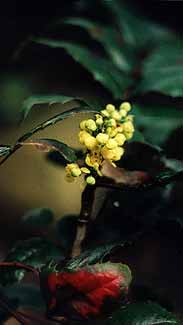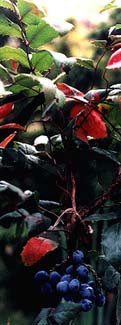
Creeping Mahonia
aka Creeping Barberry
aka Creeping Hollygrape
aka Ash Barberry
aka Small or Dwarf Oregon Grape
In its purest strains, Mahonia repens is a ground-creeper which looks like a dwarfed groundcover variety of English Holly, though of course it is not at all related to holly. It's rare to find this little shrub in its purest prostrate for, because even in nature it cross-pollinates at will with other mahonias, including M. aquifolium. This means that the Tall Oregon Grape has many dwarf forms, & the Creeping Oregon Grape has many upright forms, though as a broad generality M. repens is small, M. aquifolium is tall.
We have two of these dwarf mahonias with a clumping & more or less upright behavior, growing on a little hillside in dry shade. I'm relatively certain ours is specifically M. repens var. macrocarpa, as the berries are of substantial size, but because so many M. repens are naturally occurring hybrids, keying them out to specific variants is difficult, since natural crosses with M. aquifolium & M. pinnata guarantee varied aspects.
 In our garden, the fragrant yellow flowers are generally earlier than those of M. aquifolium which is growing atop the same little cliff. M. repens blooms in Febuary & March, ahead of its larger cousin's March & April flowering. This will greatly vary from place to place, as I see M. aquifolium blooming in some gardens (especially where it has more sun than in ours) as early as January. The bright mahonia flowers can continue to have a presence on both species up to the end of April or early June. They are loved by bees & butterflies.
In our garden, the fragrant yellow flowers are generally earlier than those of M. aquifolium which is growing atop the same little cliff. M. repens blooms in Febuary & March, ahead of its larger cousin's March & April flowering. This will greatly vary from place to place, as I see M. aquifolium blooming in some gardens (especially where it has more sun than in ours) as early as January. The bright mahonia flowers can continue to have a presence on both species up to the end of April or early June. They are loved by bees & butterflies. To produce the best fruit it needs to cross-pollinate with other specimens of M. repens or with other species of mahonia, this being achieved with the assistance of bees. However, if someone has but one specimen, it will often self-pollinate if there are no other mahonias nearby, it just won't produce nearly as many fruits. The berries ripen late August, & as soon as a night or two of frost causes them to sweeten, they will very probably be taken by birds.
While berries are still green in summer, nothing likes to eat them. They are mildly toxic, though mainly the potentially toxic alkaloids are in the leaves & stems, for which reason it is particularly deer resistant, although in many areas it is an important early spring-browse for deer & elk & bears. It begins putting out new leaves in early April, by which time the deer will have other choices they vastly prefer & the mahonia is again deer resistant for a while. There have been reports of cattle being killed by over-grazing creeping mahonia, but such incidents are rare & none documented in recent history. There is no case of toxic response in humans eating the berries, though this may be partly because they are unpallatable until they are fully ripe & been through a freeze or two, by which time they are tasty & perfectly safe.
As with other mahonias that produce fine large berries, creeping oregon grape has been used to make apple-mahonia jelly, wines, pies, & the flowers make an excellent lemonade substitute. The berries are produced in substantial numbers, blue with a white dusting. They are most edible after a frost or two which increases their fructose content & decreases their pectin content, but I've found it difficult to beat the birds to them if they're not picked ahead of the frost. The berries could last the whole winter right on the shrub if birds per chance didn't find them, but we encourage birds throughout our gardens, & that means no limb-ripened Oregon Grapes for us mere humans. The birds can yet be foiled if the berries are picked before frost & then sweetened-off by packing them them in the freezer.
In autumn the leaves turn a lovely array of bronze to purple to yellowish shades with an occasional bright red leaf, & they keep the coloration right up to spring. It spreads above ground by suckering & spreads fruther from the main plant by underground stolons; birds disperse the seeds farther still. It is sometimes necessary to keep an eye on them to keep them from spreading too much, though they're not notoriously swift in their spread.
Native of the Pacific Northwest as far inland as North Dakota, & into the American Southwest, they are hardy in the widest array of conditions. We have them in fairly deep dry shade wherein they flourish as nothing else will. In nature creeping mahonia grows best & most densely bushy under the thickest evergreen canopies, frequently in pine forests & Douglas fir forests. It's not so much the deeper shade it is benefiting by, but the acidification of the soil caused by a continuous supply of shed needles from above. If it can be provided each autumn with a thin mulch of forest needles, this will fulful one of its happiest wants.
Such deep shade is not an absolute requirement because in nature it also likes to colonize dry & fairly exposed areas, though it will not be so densely leafed in such locations. In the garden it is adaptable to either shade or sun, but may struggle in full sun, yet fail to flower well in deep shade. It'll be drought tolerant & look quite pleasing with very little watering, but its slow spread will be somewhat less poky if it does have regular watering. Well-drained rather rocky soil is its ideal.
M. repens was used by the Navajo to make a lavender dye from the berries & a yellow dye from the roots & underbark. In the Great Basin, tribes made a tea from the roots which was supposed to cure dysentery, relieve lung infections & coughs, & as a treatment of liver & venereal diseases. Most of these medicinal uses are neither substantiated nor disproven by modern science, but studies of M. aquifolium have proven it effective in treating dermatitis just as British Columbia native peoples claimed. The active ingredients would be the same for all species of Oregon Grape, & conceivably a bit more powerful in M. repens since it's known to be a little more toxic to start with.